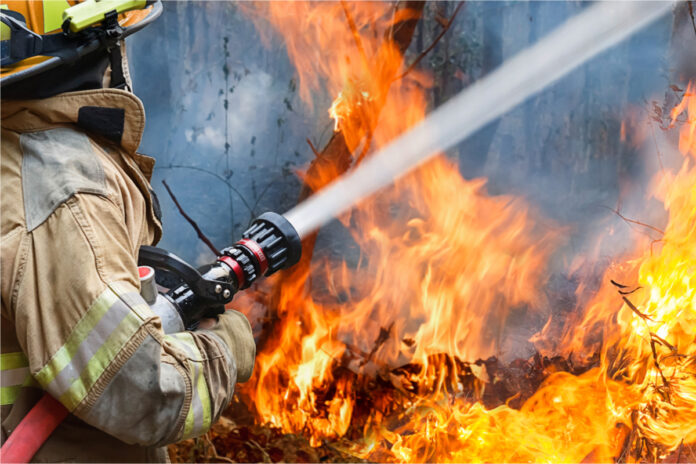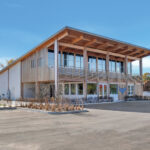WESTERN UNITED STATES – Before the most recent droughts in California, which lasted officially from 2006 to 2009 and 2011 to 2019, the state’s annual wildfire season used to start in October. However, due to climate change, wildfire season has become less predictable, beginning earlier and often stretching into the autumn months.
Ten years ago, in July 2010, the National Oceanic and Atmospheric Administration (NOAA) reported:
“Three large fires the last week of July prompted Governor Schwarzenegger to declare a state emergency in California, allowing the allocation of state resources to fight the fires. The Bull fire and West fire occurred in Kern County. Combined both fires burned 17,700 acres (6,961 hectares) and destroyed nearly forty homes and numerous other structures. The Crown fire burned 14,000 acres (5,666 hectares) in Los Angeles County. 2,300 evacuations were ordered as all three fires spread rapidly. By the end of the month the fires were mostly contained, as weather conditions became more favorable for firefighters.”
NOAA added to the 2010 report, “By July 30th, twenty-two large fires were burning across the United States with seven fires in California; three in Nevada; two in Montana, Alaska, and Florida; and one each in Washington, Oregon, Idaho, Colorado, and New Jersey.”
This, despite above average rainfall during the month. The U.S. Drought Monitor said in July 2010, severe drought conditions had spread from Wyoming to northern Arizona, while Alaska had experienced relief from moderate drought.
“In the Mid-Atlantic and Southeast, drought conditions worsened with moderate drought developing in Alabama, the Carolinas, Delaware, Pennsylvania, and New Jersey. Severe drought developed along coastal Virginia and Maryland,” the Monitor’s report continued.
Ten years later, 2020 is a year of Biblical proportions by any measure, but especially if your measure is global disasters. In 2020, a “large” fire can consume more than a million acres and be dubbed an official “gigafire.”
Trade organization Insurance Information Institute reported these statistics for U.S. wildfires, as of mid-October:
“From January 1 to October 16, 2020, there were 45,939 wildfires compared with 43,509 wildfires in the same period in 2019, according to the National Interagency Fire Center (NIFC). About 8.3 million acres were burned in the 2020 period, compared with 4.5 million acres in 2019. Six of the top twenty largest California wildfires fires occurred in 2020, according to CalFire’s list.”
As of October 13, 2020, NIFC reported the number of large fires currently burning in the U.S. at fifty, with nearly 3.5 million acres affected and none of the fires fully contained. States affected by large fires now include Arizona, California, Colorado, Idaho, Montana, New Mexico, Oregon, Utah, Washington, and Wyoming.
This list includes some of the most vital areas for agriculture in the western United States, including outdoor cannabis and hemp crops. In fact, the only state that still considers cannabis fully illegal on the list of fire-affected states is Wyoming.
The August Complex Fire, which was started by lightning strikes in mid-August, has affected Mendocino, Humboldt, Trinity, Tehama, Glenn, Lake, and Colusa Counties, and is California’s largest wildfire to date with 1,002,097 acres burned, 160 structures destroyed, and one fatality. It still is not fully contained.
For California’s Emerald Triangle, which includes legendary growing regions—like Mendocino and Humboldt—and other areas north of the Bay Area to the Oregon border, this is the third year in a row that some counties have suffered record-setting wildfires. For Oregon, Washington, and Colorado, 2020 has brought record-setting fires for the first time—but will it be the last?
What might the effects be for 2020’s cannabis crops? Will the effects of climate change also change methods or locations for outdoor agriculture for cannabis, hemp, and other crops? Are farmers growing concerned?
According to Marcus Naramore, director of marketing and business development for cannabis brand Leafwerx, growers are “Definitely concerned, you know? And I think [weather is] one of the factors in growing outdoors that we contend with. There’s a lot of advantages to it, but you never know what the weather is gonna do. You never know,” he told mg.
Headquartered in Seattle, Leafwerx’s growing operation is in Wenatchee, in eastern Washington State. Since March in Washington, 713,000 acres have burned in an unprecedented number of fires. The first week of September, eighty fires were touched off by lightning in one day and burned nearly 300,000 acres, causing the governor to declare a “historic fire event.”
Though unaffected directly by evacuation or property damage, Naramore said the company’s primary concerns were employees’ health so close to harvest time, as well as smoke taint on its budding crops.
“And then, obviously, in recent years there’s been a major uptick in fires as well. It’s becoming, like, a seasonal thing,” Naramore said. “So, our local concerns are pretty high but we’ve harvested everything now. We ran some extraction as well, and it [smoke taint] hasn’t hit us and had the adverse effects. So, we consider ourselves lucky. Some of our neighbors—I don’t know if they could say the same. I definitely think there was some smoking that could really hurt.”
Data for how smoke taint affects cannabis is virtually nonexistent, though university researchers in Oregon are studying the effects of smoke on this year’s hemp crops.
Another crop for which information on smoke taint is available is wine grapes—also grown in the lauded soil of vineyards in Washington, Oregon, and California, among other regions.
According to wine experts, smoke contains volatile phenol compounds that can impart a smoky flavor to exposed grapes, the taste of which can be detected in the final product. With the wildfires coming close to harvest time, wineries that were able harvested their grapes early for white and rose wines, which avoids the use of tainted grape skins. It’s likely to be a rough year for California reds.
“Many [cannabis] growers did harvest earlier to prevent potential contamination from smoke and/or ash, and in many of the areas affected, like in Oregon, workers were legally not allowed to work outside for extended periods due to health risks. Many were forced to delay harvest, further risking the plants and contamination,” Allay Consulting Chief Executive Officer Kim Stuck told mg.
“This happened at a very inopportune time—right before and during harvest season. Many crops were affected by the smoke and heat, and buildings used for curing, storage, and processing were lost,” Stuck explained.
“For hemp growers, having to harvest late means risking THC levels in plants rising above the allowed threshold of 0.3 percent. You have to harvest at just the right time to make sure the plants are still compliant with laws, but many were prevented from achieving that timeline due to the fires. While I don’t have an exact percentage of operations that were affected, I would imagine that if you were an outdoor grower in Oregon, at least one hardship befell you due to the fires,” she added.
At Allay, the company consults on cannabis industry operations, now including crisis management. Stuck said she’s had calls from clients in affected areas about how to minimize smoke damage.
“Mostly, they want to know how to get the ash off their plants without having to destroy their trichomes content. We came up with a series of options. Still, the best methods were covering the plants to cut down on the amount of ash that falls on them in the first place, and if ash did get on your plants, using a leaf blower to remove it was somewhat effective.
“Finally, whatever mitigation techniques are employed, many jurisdictions require testing for foreign-object debris to ensure the product is safe for consumption,” Stuck said.
Up next in mgretailer’s limited wildfire series: Joanne Cachapero examines wildfires’ affects on supply lines and prices.












